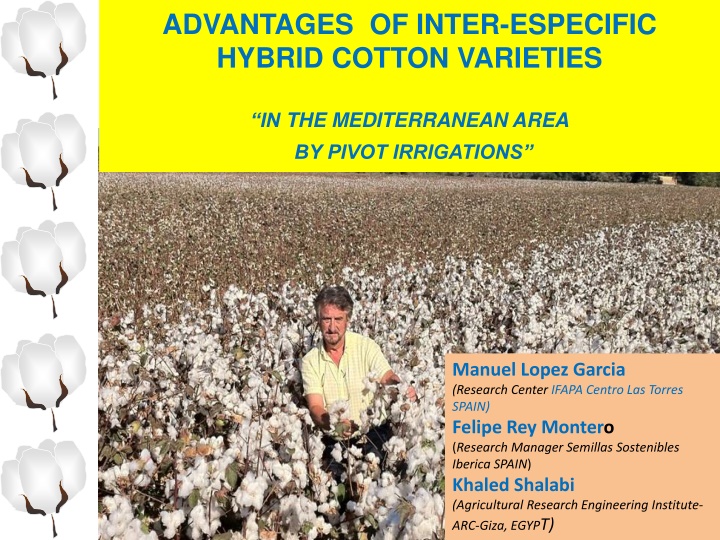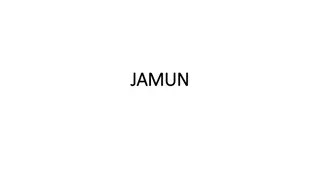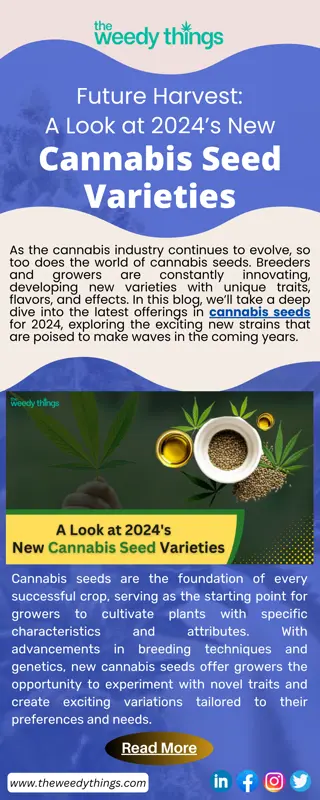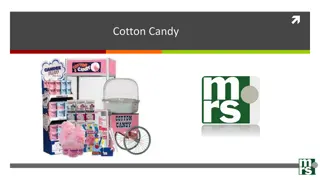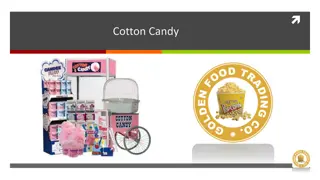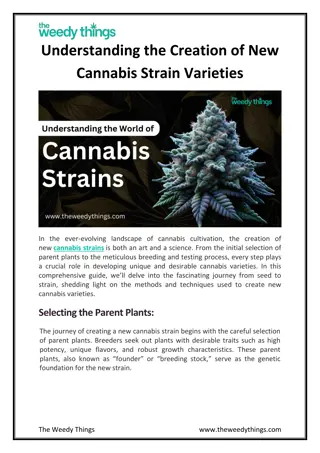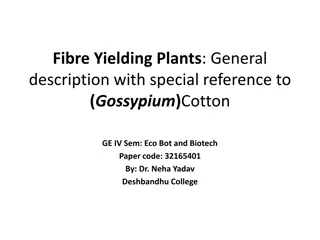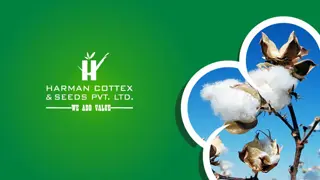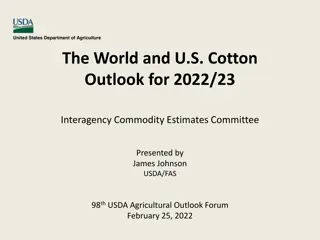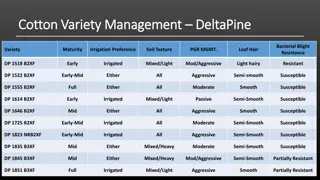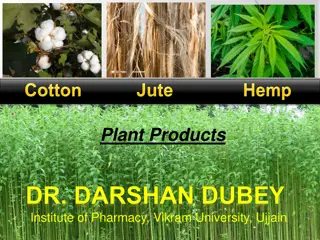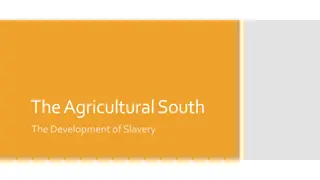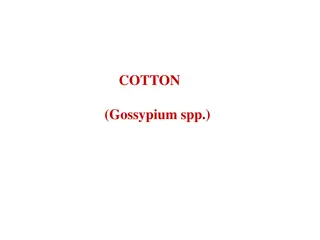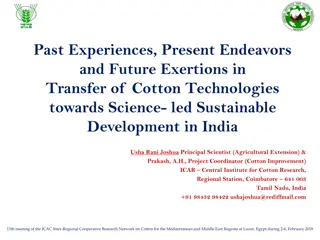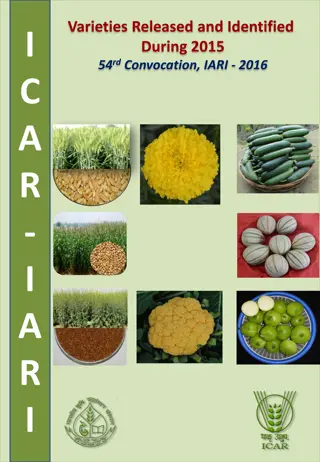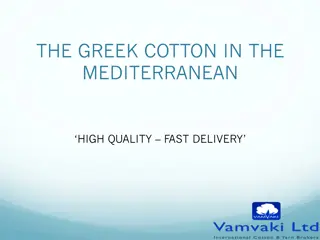Advantages of Inter-Especific Hybrid Cotton Varieties in the Mediterranean Area
The research conducted by Manuel Lopez Garcia, Felipe Rey Montero, and Khaled Shalabi focuses on studying different cotton varieties in Spain through pivot irrigation systems to determine the species best suited for the Mediterranean climate. The study, initiated in 2014, compared fertigation systems and concluded that hybrid varieties outperformed hirsutum and barbadense species, with pivot irrigation showing higher efficiency. The trials in Los Palacios monitored temperature, precipitation, and fiber production, emphasizing the importance of interspecific hybrid varieties for optimal adaptation.
Uploaded on Sep 17, 2024 | 6 Views
Download Presentation

Please find below an Image/Link to download the presentation.
The content on the website is provided AS IS for your information and personal use only. It may not be sold, licensed, or shared on other websites without obtaining consent from the author.If you encounter any issues during the download, it is possible that the publisher has removed the file from their server.
You are allowed to download the files provided on this website for personal or commercial use, subject to the condition that they are used lawfully. All files are the property of their respective owners.
The content on the website is provided AS IS for your information and personal use only. It may not be sold, licensed, or shared on other websites without obtaining consent from the author.
E N D
Presentation Transcript
ADVANTAGES OF INTER-ESPECIFIC HYBRID COTTON VARIETIES IN THE MEDITERRANEAN AREA BY PIVOT IRRIGATIONS Manuel Lopez Garcia (Research Center IFAPA Centro Las Torres SPAIN) Felipe Rey Montero (Research Manager Semillas Sostenibles Iberica SPAIN) Khaled Shalabi (Agricultural Research Engineering Institute- ARC-Giza, EGYPT)
Objectives of the study The main objective of this research is the study of the behavior of the different varieties planted in Spain through fertirrigations system through pivot in order to observe which species are better adapted to our growing needs This study started in 2014 and was presented by the same authors in Sharm El Sheikh October 2015. The study presented in 2015 compared the two most efficient fertirrigation systems LEPA irrigation (Low energy applications precision) and its impact on the varieties studied in both performance (kg / ha) and fiber characteristics (HVI system). The conclusions of the trial demonstrated the supremacy of the hybrid varieties against the hirsutum and barbadense, and regarding the irrigation system, the pivot system demonstrated greater efficiency.
Introduction Spain cotton area has "Mediterranean climate", the temperature varies widely during the growing season (April-October), variations between 15 C to 43 C. are normal
Average T Year 2016 in trials area Red color T Max Green color T Average Blue color T Min
AVERAGE T YEAR (2016) In Trial rea Los Palacios whether stations 2016 Month T Max. % T Min. % T Max. % HR Average % Precipitaci n mm April May Jun July August September October 22,1 25,1 31,5 33,8 33,7 31 9,3 12,4 15,4 18,5 18,4 15,1 15,4 18,4 23,3 25,8 25,7 22,4 80,2 73,6 62,1 67,4 64,8 68,5 64,6 148,2 0,4 1 1,6 5,6 26,3 13,7 19,2 79,3 95,4 316,8
Introduction ELS fiber production began in Spain in 2007 and in 2016 reached 5.500 hectares with an average yield of fiber of 1.600 kg / has The ELS varieties used by producers are only interspecific hybrid varieties, are the only ones able to adapt to our GD-15,5C GD-15,5C has a range between 1.150 GD/1.350 GD Manuel Lopez Garcia
The graphics show 1.285 DG-15,5C (from planting to harvest )
Material and methods The field was located in Seville (Spain SW 37 4'N) The soil type is called "Vertisol" (deep, fertile soil and its physical composition is clay loam)
Material and methods The trial consists in thirteen varieties with four replications (split plot). The elemental plot was 4 row 10 meters long with a separation between row 0.75 meters. The distance between repetitions was two meters. The planting was effected on April 28, resulting population density was 100.000 plants/Ha
Material and methods Varieties Used in the Trial VARIETIES USED HYBRID HA-1432 HA-211 HA-670 HA-701 GW-2002 GW-2005 GW-2007 GW-2008 GW-2012 G. BARBADENSE ARMADA E-1 G. HIRSUTUM ELPIDA CAMPO The Hirsutum and Barbadense varieties used in the trial are commercial varieties. The hybrids there are 4 commercial varieties and the rest are experiential varieties in ways to be registered in OECD. The seed used was delinting seed with sulfuric acid and treated with carboxin at the usual doses
Material and methods P vot Caracteristic Center Pivot Western 8120 model for 60Ha. 6-5/8 diameter spans and Overhang with Flexible drops at 1.2m over the ground, 15PSI Pressure Regulators and Nelson D3000 Sprays with Brown pads (For low crop as cotton). High float Wheels and 1HP UMC gearmotors The approximate caudal is 1,3 liters/seconds/hectare
Material and methods PIVOT CALENDAR 2016 CALENDA 3.690 m3/Ha 350 300 300 250 250 250 220 200 200 M3/HA 200 150 150 150 150 150 150 150 150 150 150 150 150 150 120110120 120 100 50 28-4 10-5 20-5 21-5 31-5 10-6 20-6 30-6 11-7 16-7 21-7 26-7 31-7 10-8 15-8 20-8 27-8 14-9 24-9 6-7 5-8 4-9
Material and methods For the analysis of monitoring and predictions irrigation strategies has been used simulation software "PRECISION CROP MANAGEMENT" The following screens allow us to better understand the qualities of this program
Agronomic Variety Results Yield (gross & fiber) TRIALS 2016 YIELD GROSS YIELD FIBER % VARIETIES GTO H-1432 H-211 H-670 H-701 GW-F1-2002 GW-F1-2005 GW-F1-2007 GW-F1-2008 GW-F1-2012 ARMADA E-1 ELPIDA CAMPO 5.462 4.410 4.480 4.115 4.330 5.360 4.741 4.678 5.732 4.600 3.550 4.410 4.385 1.934 1.491 1.590 1.477 1.546 1.919 1.716 1.665 2.012 1.559 1.250 1.738 1.706 35,4% 33,8% 35,5% 35,9% 35,7% 35,8% 36,2% 35,6% 35,1% 33,9% 35,2% 39,4% 38,9%
Agronomic Varieties Results Yield (gross & fiber) TRIALS 2016 YIELD GROSS/Kg YIELD FIBER/Kg % SPECIES GTO AVERAGE HYBRIDS 4.812 1.706 35,4% AVERAGE BARBADENSES 4.075 1.405 34,6% 39,2% AVERAGE HIRSUTUM 4.398 1.722 6,000 5,000 4,000 YIELD GROSS/Kg 3,000 YIELD FIBER/Kg 2,000 1,000 0 AVERAGE HYBRIDS AVERAGE BARBADENSES AVERAGE HIRSUTUM
Quality Fiber 2016 HVI TRIALS 2016 ANALYSIS HVI VARIETIES LEN STR MIC UNIF ELONG H-1432 34,1 41,8 4,4 86,4 8,2 H-211 33,7 41,6 4,2 86,6 7,2 H-670 33,3 39,9 4,3 86,5 6,2 H-701 32,5 40,9 3,8 86,3 7,3 GW-F1-2002 34,4 40,6 3,4 86,4 6,5 GW-F1-2007 34,8 41,4 3,3 87,7 7,3 GW-F1-2008 34,3 42,7 3,4 86,5 7,3 GW-F1-2012 34,4 40,9 3,3 86,3 6,6 ARMADA 33,2 42 4,4 85,3 7,6 E-1 36,7 47,7 3,7 89,2 6,1 ELPIDA 30 32,6 4,6 87,8 7,8 CAMPO 28,9 29,8 4,7 86 8,7
Quality Fiber 2016 HVI Main Parameters 100 90 80 70 60 LEN 50 STR MIC 40 UNIF ELONG 30 20 10 0
Quality Fiber Lengh LEN 40 35 H-1432 30 H-211 H-670 25 H-701 GW-F1-2002 20 GW-F1-2007 GW-F1-2008 15 GW-F1-2012 10 ARMADA E-1 5 ELPIDA CAMPO 0
Quality Fiber Strengh STR 60 50 H-1432 H-211 40 H-670 H-701 GW-F1-2002 30 GW-F1-2007 GW-F1-2008 20 GW-F1-2012 ARMADA E-1 10 ELPIDA CAMPO 0
Quality Fiber Micronair MIC 5 4.5 4 3.5 3 2.5 2 1.5 1 0.5 0
Quality Fiber Uniformity UNIF 90 89 88 87 86 85 84 83
Quality Fiber Elongations ELONG 10 9 8 7 6 5 4 3 2 1 0
Conclutions The results obtained in this trial, carried out in 2016 and presented at Luxor 2018, reinforce the data obtained in 2014 and presented in 2015 in Sharm El Sheik. YIELD Kg/Ha. The yield in kg / Ha / fiber of the hybrid varieties was equal or superior to the hirsutum varieties and much higher than the Barbadian varieties The yield in kg / Ha / gross of the hybrid varieties was higher than the hirsutum varieties and much higher than the Barbadian varieties The vigor of the hybrids allowed its viability in extreme conditions impossible for the Barbadian varieties FIBER QUALITY (HVI) The quality of the fiber measured in HVI of the hybrid varieties (all within the ELS parameter) was lower than that of the California-type Barbadian varieties and very similar to the Asian-like Barbadian varieties
